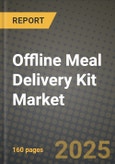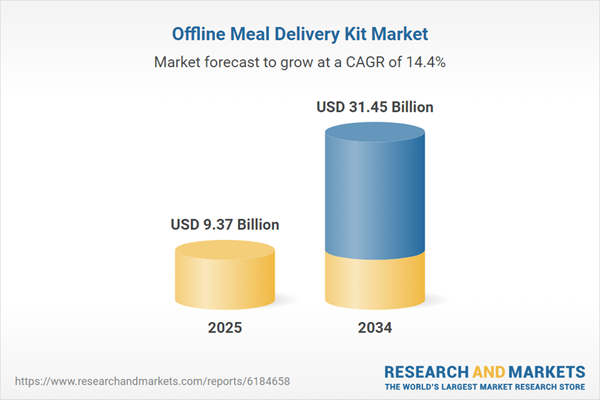Offline Meal Delivery Kit Market
The offline meal delivery kit market comprises ready-to-cook, portioned meal solutions merchandised through supermarkets, convenience stores, specialty grocers, clubs, kiosks, and vending in high-traffic sites. Core end-uses include weeknight family meals, premium at-home dining, health and diet plans, lunch and small-household occasions, and entertaining or seasonal gatherings. Latest trends emphasize chef and restaurant collaborations, authentic regional cuisines, plant-forward and high-protein variants, microwave/air-fryer finishes, and QR-enabled step guidance. Growth is driven by time-poor shoppers seeking predictable outcomes, reduced food waste, portion control, and “no subscription, no waiting” immediacy with supermarket price trust. The competitive landscape spans retailer private labels, branded specialists, commissary and co-manufacturing networks, and foodservice brands extending into retail; advantage accrues to players with cold-chain discipline, rapid menu refresh, and scalable packaging. Sustainability and margin needs push mono-material packs, rPET content, lightweighting, and clear recyclability instructions. Retail media and loyalty data sharpen targeting and encourage cross-category bundles with beverages, salads, bakery, and desserts. Operational resilience hinges on ingredient modularity, late-stage assembly, and demand sensing to balance availability and shrink. Nutrition transparency, allergen governance, and clean-label cues are baseline expectations, while store execution - planogram compliance, secondary placements, and endcaps - largely determines real-world sell-through. Overall, the category competes effectively with online kits and prepared foods by offering curated flavors, clear prep times, and immediate gratification, while retailers leverage tiered assortments to capture trade-up and defend share.Offline Meal Delivery Kit Market Key Insights
- Occasion-led portfolio architecture wins.
Maintain a tight evergreen core plus rotating seasonal and regional editions.
Signal servings, tools, and prep time prominently on pack.
Use color icons and occasion language to reduce choice friction at shelf.
Cross-merchandise with wine, salads, and desserts to lift basket value.
Guard against cannibalization via distinct proteins, flavors, and price tiers.
- Culinary credibility drives trial and premium trade-up.
Provenance storytelling for sauces and key ingredients builds trust.
QR codes unlock short technique videos and substitution tips.
Taste consistency across banners underpins repeat purchase and advocacy.
Premium tiers justify pricing via portion size and finishing touches.
Limited series create urgency and earned media without heavy spend.
- Packaging is a performance and sustainability lever.
Pre-portioned pouches cut prep complexity and reduce waste.
Easy-open features and step-numbered components streamline cooking.
Condensation and purge control protect appearance and quality.
On-pack QR explains local recycling pathways to avoid greenwashing.
Verified recycled content supply strengthens retailer negotiations.
- Cold-chain and store execution determine experience.
Ingredient modularity enables late substitutions when supply shifts.
FIFO routines, planogram discipline, and facing standards curb shrink.
Back-of-house playbooks standardize handling across formats.
Return analysis feeds recipe simplification and spec tightening.
Mystery audits align vendors and stores on quality outcomes.
- Nutrition and wellness segmentation is now table stakes.
Plant-forward and flexitarian SKUs broaden reach without alienating meat eaters.
Dietitian-reviewed lines resonate in health-oriented banners and pharmacies.
Portion-controlled formats meet lunch and weight-management needs.
Clean-label cues must match real formulations to sustain trust.
Functional pairings with beverages enable higher-margin bundles.
- Data and retail media amplify ROI.
Heatmaps inform secondary placements near proteins and produce.
A/B tests tune price ladders, pack sizes, and promo cadence.
Post-purchase QR surveys capture NPS and friction points for sprints.
Digital content should mirror shelf messaging for continuity.
Closed-loop attribution links impressions to household baskets.
- Private label sophistication raises the bar.
Exclusive flavors and pack sizes create defensible positions.
Co-manufacturing near DCs shortens lead times and improves freshness.
Joint business plans trade supply assurance for endcaps and media.
National brands win via protected IP blends and faster NPD cycles.
Price defense alone underperforms versus distinctive experiences.
- Format and equipment innovation expand occasions.
Air-fryer and microwave finishes compress prep without quality loss.
Modular kits allow protein swaps without SKU explosion.
Grab-and-go kiosks and vending capture transit and campus traffic.
Snackable sides and appetizers broaden usage beyond dinner.
“Pantry-plus-fresh” hybrids improve affordability and stability.
- Regulatory and food-safety discipline are non-negotiable.
Date coding, storage, and thawing instructions minimize misuse.
Traceability readiness and recall protocols safeguard equity.
Local labeling rules shape claims, origin, and nutrition copy.
Supplier audits and documentation must be inspection-ready.
Associate training closes the last-meter quality gap.
- Partnership ecosystems unlock speed and distinctiveness.
Ingredient partners co-develop sauces for ownable flavor systems.
Packaging vendors collaborate on recyclability and shelf efficiency.
Cross-promotions with beverages and tableware deliver themed bundles.
Event-led exclusives align with holidays and sports moments.
Community initiatives strengthen trust and repeat visitation.
Offline Meal Delivery Kit Market Reginal Analysis
North America
Retailers lean on deep private label, chef partnerships, and retail media to defend share against prepared foods and online kits. Loyalty data tailors offers and informs cross-merchandising with beverages and bakery. Labor variability and logistics complexity favor centralized commissaries, simplified assemblies, and modular ingredients. Wellness-led assortments with clear macros and allergen transparency are expected. Urban convenience formats prioritize compact, impulse-friendly packs, while clubs scale family-size value bundles and seasonal entertaining kits.Europe
Strong private label capabilities and strict labeling norms drive clean ingredients and detailed nutrition disclosure. Provenance and regional cuisines - Mediterranean, Alpine, Nordic - anchor premium tiers, while discounters push streamlined value kits with predictable rotations. Sustainability expectations accelerate mono-material packaging and in-store recycling guidance. Proximity stores and click-and-collect extend reach beyond hypermarkets. Food-safety rigor and allergen governance reward suppliers with documentation discipline and consistent quality outcomes.Asia-Pacific
Diverse culinary traditions and fast urban lifestyles require high rotation and hyper-localization - from donburi and Korean BBQ to Indian curries and Southeast Asian stir-fries. Convenience stores, transit hubs, and supermarkets are key, with single-serve and small-family formats gaining traction. Price sensitivity coexists with willingness to pay for authenticity and spice accuracy. Near-store assembly mitigates freshness challenges in tropical climates. QR-led video guidance and social sharing accelerate education and trial.Middle East & Africa
Expat and tourism centers sustain premium international cuisines alongside regional favorites. Harsh climates elevate cold-chain rigor, moisture-resistant packaging, and clear storage instructions. Modern trade and upscale convenience formats dominate, with opportunities in hotels, serviced apartments, and corporate campuses. Halal compliance, bilingual labeling, and allergen clarity are essential. Seasonal peaks tied to holidays and events favor limited-time bundles, family sharing formats, and premium entertaining kits.South & Central America
Traditional flavors and value positioning lead, complemented by aspirational international cuisines in major metros. Hypermarkets and warehouse clubs drive volume; neighborhood stores trial smaller packs aligned with weekly budgets. Local sourcing of produce and proteins stabilizes cost and freshness. Clear instructions and minimal equipment requirements broaden appeal across demographics. Promotional cycles and rotating menus align with pay periods and national holidays to maximize sell-through and curb shrink.Offline Meal Delivery Kit Market Segmentation
By Type
- Ready-to-eat Food
- Reprocessed Food
- Others
By Age Group
- Below 25
- 25 to 60
- Above 60
Key Market players
HelloFresh, Blue Apron, Home Chef, Dinnerly, Marley Spoon, EveryPlate, Green Chef, Purple Carrot, Gousto, My Food Bag, Inzyy, Chef’d, The Honest Company, Hungryroot, Little SpoonOffline Meal Delivery Kit Market Analytics
The report employs rigorous tools, including Porter’s Five Forces, value chain mapping, and scenario-based modelling, to assess supply-demand dynamics. Cross-sector influences from parent, derived, and substitute markets are evaluated to identify risks and opportunities. Trade and pricing analytics provide an up-to-date view of international flows, including leading exporters, importers, and regional price trends.Macroeconomic indicators, policy frameworks such as carbon pricing and energy security strategies, and evolving consumer behaviour are considered in forecasting scenarios. Recent deal flows, partnerships, and technology innovations are incorporated to assess their impact on future market performance.
Offline Meal Delivery Kit Market Competitive Intelligence
The competitive landscape is mapped through proprietary frameworks, profiling leading companies with details on business models, product portfolios, financial performance, and strategic initiatives. Key developments such as mergers & acquisitions, technology collaborations, investment inflows, and regional expansions are analyzed for their competitive impact. The report also identifies emerging players and innovative startups contributing to market disruption.Regional insights highlight the most promising investment destinations, regulatory landscapes, and evolving partnerships across energy and industrial corridors.
Countries Covered
- North America - Offline Meal Delivery Kit market data and outlook to 2034
- United States
- Canada
- Mexico
- Europe - Offline Meal Delivery Kit market data and outlook to 2034
- Germany
- United Kingdom
- France
- Italy
- Spain
- BeNeLux
- Russia
- Sweden
- Asia-Pacific - Offline Meal Delivery Kit market data and outlook to 2034
- China
- Japan
- India
- South Korea
- Australia
- Indonesia
- Malaysia
- Vietnam
- Middle East and Africa - Offline Meal Delivery Kit market data and outlook to 2034
- Saudi Arabia
- South Africa
- Iran
- UAE
- Egypt
- South and Central America - Offline Meal Delivery Kit market data and outlook to 2034
- Brazil
- Argentina
- Chile
- Peru
Research Methodology
This study combines primary inputs from industry experts across the Offline Meal Delivery Kit value chain with secondary data from associations, government publications, trade databases, and company disclosures. Proprietary modeling techniques, including data triangulation, statistical correlation, and scenario planning, are applied to deliver reliable market sizing and forecasting.Key Questions Addressed
- What is the current and forecast market size of the Offline Meal Delivery Kit industry at global, regional, and country levels?
- Which types, applications, and technologies present the highest growth potential?
- How are supply chains adapting to geopolitical and economic shocks?
- What role do policy frameworks, trade flows, and sustainability targets play in shaping demand?
- Who are the leading players, and how are their strategies evolving in the face of global uncertainty?
- Which regional “hotspots” and customer segments will outpace the market, and what go-to-market and partnership models best support entry and expansion?
- Where are the most investable opportunities - across technology roadmaps, sustainability-linked innovation, and M&A - and what is the best segment to invest over the next 3-5 years?
Your Key Takeaways from the Offline Meal Delivery Kit Market Report
- Global Offline Meal Delivery Kit market size and growth projections (CAGR), 2024-2034
- Impact of Russia-Ukraine, Israel-Palestine, and Hamas conflicts on Offline Meal Delivery Kit trade, costs, and supply chains
- Offline Meal Delivery Kit market size, share, and outlook across 5 regions and 27 countries, 2023-2034
- Offline Meal Delivery Kit market size, CAGR, and market share of key products, applications, and end-user verticals, 2023-2034
- Short- and long-term Offline Meal Delivery Kit market trends, drivers, restraints, and opportunities
- Porter’s Five Forces analysis, technological developments, and Offline Meal Delivery Kit supply chain analysis
- Offline Meal Delivery Kit trade analysis, Offline Meal Delivery Kit market price analysis, and Offline Meal Delivery Kit supply/demand dynamics
- Profiles of 5 leading companies - overview, key strategies, financials, and products
- Latest Offline Meal Delivery Kit market news and developments
Additional Support
With the purchase of this report, you will receive:- An updated PDF report and an MS Excel data workbook containing all market tables and figures for easy analysis.
- 7-day post-sale analyst support for clarifications and in-scope supplementary data, ensuring the deliverable aligns precisely with your requirements.
- Complimentary report update to incorporate the latest available data and the impact of recent market developments.
This product will be delivered within 1-3 business days.
Table of Contents
Companies Mentioned
- HelloFresh
- Blue Apron
- Home Chef
- Dinnerly
- Marley Spoon
- EveryPlate
- Green Chef
- Purple Carrot
- Gousto
- My Food Bag
- Inzyy
- Chef’d
- The Honest Company
- Hungryroot
- Little Spoon
Table Information
| Report Attribute | Details |
|---|---|
| No. of Pages | 160 |
| Published | November 2025 |
| Forecast Period | 2025 - 2034 |
| Estimated Market Value ( USD | $ 9.37 Billion |
| Forecasted Market Value ( USD | $ 31.45 Billion |
| Compound Annual Growth Rate | 14.4% |
| Regions Covered | Global |
| No. of Companies Mentioned | 15 |









